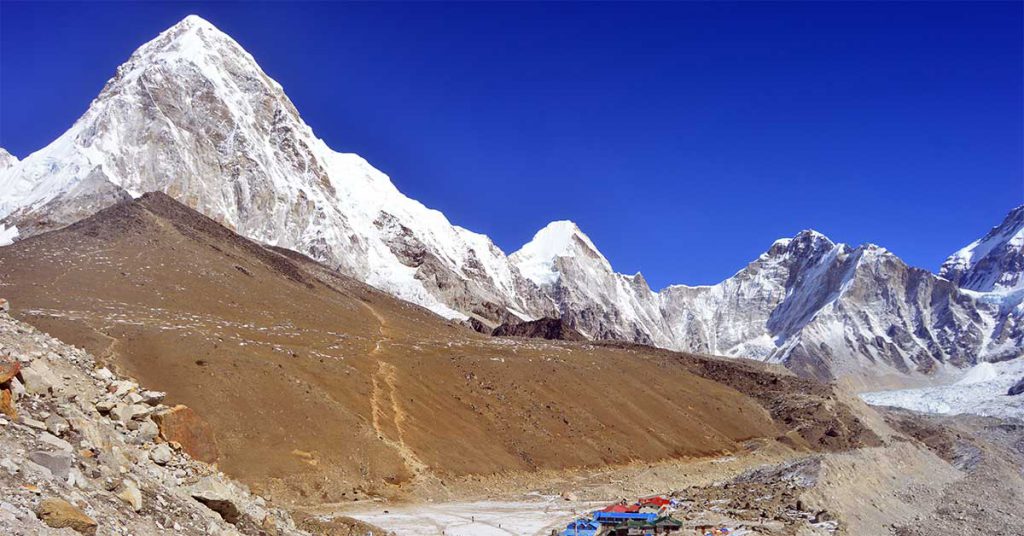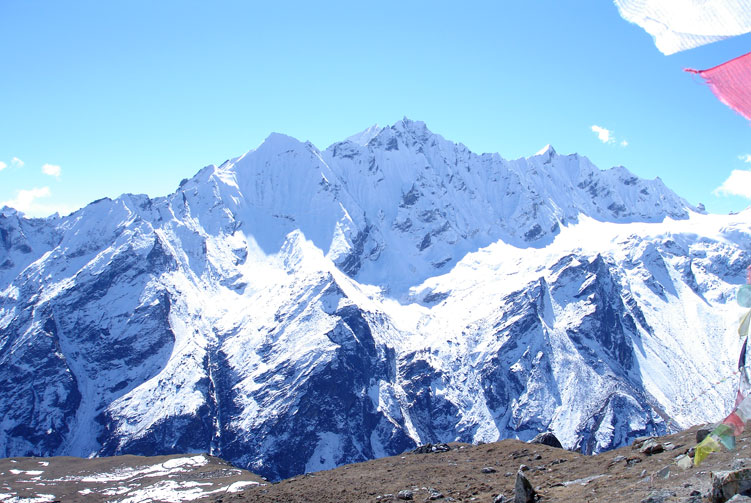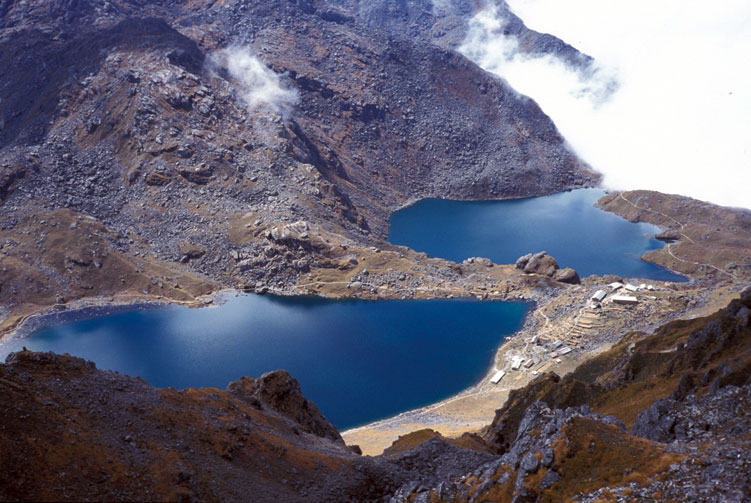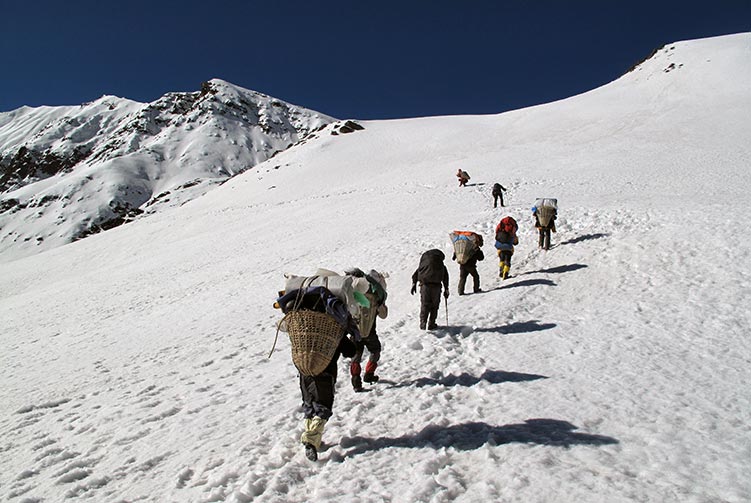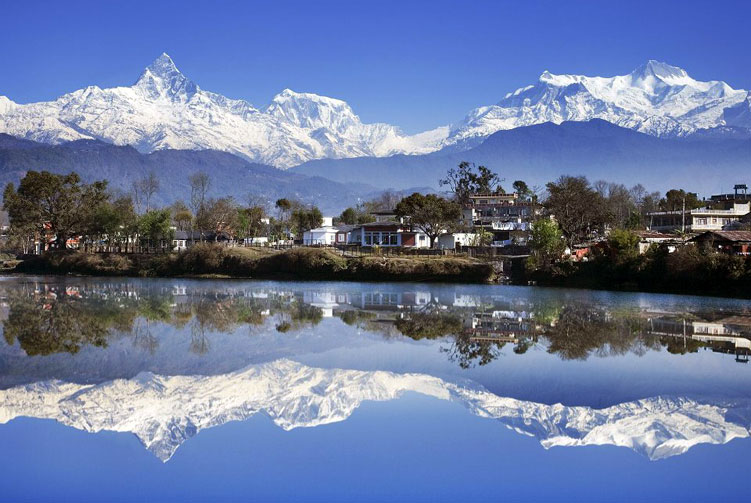Classic Everest Base Camp Trekking is an adventure trekking package that allows you to traverse the trekking trail that used to be a regular trekking trail prior to 1964. After the construction of Lukla airport, the trekkers started flying to Lukla and begin the trek that is almost a week shorter than the original one.
Overview
This trek brings you closer to the cultural and natural marvels that those Everest trekkers prior to Lukla airport construction only could experience. Adventurous trails, serene natural atmosphere, majestic mountain views, local ethnic cultures and many other wonders keep the stretch immensely interesting and great experiential route before meeting the route from Lukla. You will be already well acclimatized to go higher to the base camp as, on the classic stretch, you gain and lose a vast range of elevation. Crossing Lamjura pass at the elevation of 3,600 meters above sea level is the highest point you reach before meeting the now regular EBC trekking trail.
Once you meet the regular base camp trail after a week of classic route trekking experience, you go deeper and higher into the Sagarmatha National park and enjoy the charm and vibrations from the mighty mountains, including Mt. Everest. It is a special exploration of the Everest region that very few adventurous people do these days. Although it feels longer than the regular Everest base camp trek, it well worth taking the challenge.
Itinerary
Today is the day of your arrival in Kathmandu, Nepal. As soon as you come out of the Kathmandu airport, you will find our representative waiting for you in the waiting area right outside the arrival lounge. You will be warmly greeted and welcomed by the representative and led to the vehicle. Our vehicle will take you to the trip hotel, most of the time in Thamel, that is 20-30 minutes drive, depending upon traffic, from the airport.
Enjoy your breakfast at the hotel. We come to take your for a wonderful cultural heritage tour of Kathmandu valley. As part of the tour, we are going to visit four of the UNESCO Heritage monuments in Kathmandu valley. The places we visit today are incredible mixture of culture, history, spirituality, art and stories. Overnight in Hotel.
Swoyambhunath
Believed to have been created on its own, this Budhhist stupa is the oldest of all the monuments in Kathmandu valley. Standing atop a small hillock, Swoyambunath, known as monkey temple amongst tourists, provides a fascinating view of the valley, surrounding hills and snow-capped mountain at the distance on a clear day.
Patan Durbar Square
One of the three medieval palace squares, Patan Durbar Square holds its medieval art and architectural grandeur. Amazing skill of the artisans is evident in each and every building that stands in the square. The square comprises of medieval palace, temples and museum.
Pashupatinath
This site is the most sacred Hindu temple area in the country. But, as the temple is strictly a Hindu only area, non-Hindu tourists go there to watch the unique Hindu cremation rituals on the bank of River Bagmati. The death rites of Hindu family there are so engrossing and heart-touching which make you feel the moment. It’s not any kind of intrusion in being there and watching somebody being cremated in an open ground. It’s a great cultural experience.
Boudhanath
This giant Buddhist stupa is considered as the biggest one in the world. This small square with giant shrine has a powerful presence of the spiritual vibrations. It’s an important pilgrimage site for the people following Tibetan Buddhism.
The journey of the day starts very early today to drive to Bhandar via Jiri and Shivalaya to the east from Kathmandu. It is a day to experience the countryside drive and also see the rural life style a bit, though from the bus. The drive reache Jiri bazar and advances further towards Bhandar via Shivalaya. It’s going to be a long day on bumpy road so by the time we reach the destination we will be tired enough to feel like going to bed straight.
It is the first day of trek on the classic Everest base camp trekking route. Our trek takes us to Sete today to show us the rural atmosphere of Nepal on the very first trekking experience. Following the trail that Everest base camp trekkers and mountaineers used to walk through before the Lukla airport came into operation, we trek towards the destination. We enjoy the beautiful natural settings of the region before reaching Sete for overnight stay.
Sete to Junbesi stretch of the trek today brings us some incredible rural and natural beauties. The first stretch goes steep uphill towards Lamjura pass that stands at the elevation of 3,600 meters above sea level. The trail that leads us to the pass is quite tricky and a difficult, concentrated traverse. The trail also goes through forested area that gives us a nature walking experience. After reaching Lamjura Pass, it’s now turn to descend all the way to Junbesi to stay overnight.
We wake up for a greeting view of the Numbur Himal Poking out from the hilly ridge line. Our walk to Nuthala today is another astonishing day with walk through pine forest, view of Lamjura pass, panoramic Himalayan view of Mera peak, Katenga, Thamserku and top of Everest etc. and several other wonders. The view of the Himalayas slowly disappears from our view as we descend below towards the valley to reach Nunthala to stay overnight. We walk past the villages of Phurteng, Ringmo and several small stupas and mani walls along the trail.
On the trek to Bupsa today, we start with a descent after the breakfast. The rocky and unstable trail passes through forested area and all the way down to Dudh Koshi River bank. The river comes all the way from the Ngozumpa glacier in the Gokyo region. After crossing a suspension bridge over the river, the trail to Bupsa gets steeply uphill and we have to do that for the rest of the day. Although it’s an uphill walk, we can experience so many wonderful natural and cultural beauties. We walk past terrace rice fields and local villages of Jubing and Khari Khola. We eventually reach Bupsa to stay overnight.
Bupsa to Surkhe walking stretch is another amazing day today. The first section of the trail continues on the ascent towards Khari La. The trail is pretty tricky with uneven rocky surface on the rocky hill. The day brings the view of some mountains and a view of stretching Dudh Koshi river valley. Once we reach Khari La, we can see Lukla and the river valley along. Walking past the Paiyan village, we descend all the way down to Surkhe to stay overnight.
As Surkhe lies at the bottom of the valley, we, on our trek today, have to walk uphill to come out of the valley first. The trail is fairly easier than the one we had taken yesterday. When we reach Chaurikharka, we can meet even easier, broader trail. Along the way, we walk past several mani walls, small chhortens and prayer wheels. The view of Dudh Koshi river valley still accompanies us and reliefs us of walking tiredness with its vast and mysterious charm. We reach Cheplung village to meet the regular Everest base camp trail that comes from Lukla. We finish walking the classic trail route and enter regular and commonly used trail walking towards Phakding along the Dudh Koshi valley. Phakding village lies beautifully on the bank of Dudh Koshi River where we spend the night.
It’s a beautiful day of walking into the Sagarmatha National Park. We relish the mouthwatering breakfast as a gentle breeze comforts the morning. We set off on the trek for the day and reach Monjo to enter the national park zone. After checking into the park, we head up towards Namche Bazar. Crossing suspension bridges over the river in several places; passing through forested parts and many wonderful views, we finally reach Namche Bazar. Namche Bazar is a beautiful settlement on a mountain slope with the view of Himalayan peaks right in front. It is also an important trade center in Everest region. Overnight in Lodge.
An additional day of exploring around Namche is required to acclimatize with the thinning air as we go higher. We hike to the Everest view point to get the very first glimpse of Mt. Everest along with other impressive peaks in the region. We can hike up to Khumjung if you like to. The hiking to a higher elevation will help us acclimatize properly so that we can walk further higher. We return back to Namche Bazar in the afternoon and wander around the bazar. A relaxing afternoon will reenergize and prepare us for the next day. Overnight in Lodge.
A fresh morning with the view of mountain peaks makes our breakfast even tastier. Filled with the energy, we are ready for the day to walk to Tengboche. The first section of the walk gently climbs and then goes much flatter before descending to the river and cross a suspension bridge. After crossing the suspension bridge, it is obvious that the trail is ascending towards Tengboche.
We reach Tengboche to be greeted by the spectacular view of Mt. Ama Dablam along with the view of the Mt. Everest and other peaks around. Apart from enjoying the view of the Himalayan peaks, we can explore the famous Tengboche Monastery where the first Everest Summiteer Tenzing Norgay Sherpa once lived as a monk. Overnight in Lodge
We leave the comfort of the lodge and head towards Dingboche. The walk passes through the Diboche and Pangboche villages. Pangboche village has a beautiful monastery that is the largest one in the area and has a scalp of Yeti. After exploring the monastery, we take the trail towards Dingboche.
Dingboche is a beautiful Sherpa village that stands at the elevation of 4,410 meters above sea level and projects an incredible view of the mountain peaks. This village is a common stopover place for the trekkers and climbers to Everest Base Camp, Ama Dablam and Island Peak. Overnight in Lodge.
At the elevation of 4,410 meters above sea level here and much higher to go, we are in need of an additional day to acclimatize. For the purpose, we go for a day hiking trip to a higher point near and around Dingboche. The day will bring us breathtaking views of the Himalayan peaks. We return back to Dingboche from the hike and go to explore the surrounding for a while. Overnight in Lodge.
At the elevation of 4,410 meters above sea level here and much higher to go, we are in need of an additional day to acclimatize. For the purpose, we go for a day hiking trip to a higher point near and around Dingboche. The day will bring us breathtaking views of the Himalayan peaks. We return back to Dingboche from the hike and go to explore the surrounding for a while. Overnight in Lodge.
Today is the day when we make it to the destination of this epic journey. We trek to the Everest base camp via Gorakshep after stopping for the lunch there. Gorakshep serves as our overnight site for the day. After checking in the lodge at Gorakshep, we set off on the journey to the epic Everest base camp. The trail to the base of the highest mountain in the world is full of glacial moraine and boulders. We reach the base camp and spend some wonderful time there taking pictures and absorbing the mountain vibes.
We, later, walk back to Gorakshep to stay overnight
The hike that we are going to go for this early morning is taking us to the maximum elevation of the trip. When we hike to Kalapatthar for a marvelous sunrise over the panoramic Himalayan range, we will be at the elevation of 5,545 meters above sea level, the highest point on this trek.
We watch the sun rise beautifully over the magnificent mountains; take picture of the mountains and the sunrise and, later on, return back to lodge at Gorakshep for breakfast. Hungrily devouring the breakfast, we fill up ourselves with much needed energy to go back. We are trekking back to Pheriche today. Overnight at a lodge.
The journey back down to Namche Bazar will be of around eight hours. Leaving the Everest and other mountains in the region far behind, we descend long hours down to Namche Bazar. We can take some relaxing stroll around Namche Bazar in the evening or just stay inside the comfort of the lodge. Overnight at a lodge.
The final day of this trek is eventually here today. We walk back to Lukla via Monjo and Phakding along the Dudh Koshi River. A round trip on the Everest Base Camp trail comes to end here. We celebrate the end of the trekking part of the journey and thank our wonderfully amazing supporting crew members for their service and effort to take us to the base camp and back safely. Overnight at a lodge.
We get ready for the flight back to Kathmandu. We board the plane at Lukla airstrip and fly back to Kathmandu. Once we land in Kathmandu airport, we go to hotel and spend the whole day at leisure on our own. Finding relieving massage, good food, souvenir shopping, and wandering around can keep you busy for the day.
A farewell dinner is scheduled for this evening. We will let you know the departure time for dinner once we reach Kathmandu.
This is an additional day in the itinerary to compensate any possible delays on the trekking or cancellation of the flights. We extremely recommend that you have at least 2 extra days after the itinerary days so to maintain any possible delays or cancellation of the flight. If everything goes without any problem, you can utilize those extra days doing some other activities.
The final day of the trip, we drive you to airport for your scheduled flight homebound or other destination. We will pick you up 3 hours prior to your flight schedule.
The Trip Cost Includes
- Airport Pick and Drop in Kathmandu by Private vehicle.
- Welcome and Farewell dinner with cultural program.
- 4 Nights Tourist Standard Hotel Accmmodation in Kathmandu with B/B basis.
- Half day guided city tour with entrance permit.
- Transportation from Kathmandu to Bhandar by Local Bus, Flight Ticket form Lukla to Kathmandu with airport TAX.
- Standard Lodge Accommodation (best available) with twin sharing basis during the trek.
- Full Board Meals (3 Meals a day) while on the trek.
- Trekking Permit and Trekker's Information Management System (TIMS) card fees.
- Professional & highly expertise government licensed holder Trekking Guide.
- 2:1 Porters to carry luggages.
- All expenses of the staffs (Guides/Porters) that includes Food, Accommodation, Salary, Insurance, Equipment during your travel period.
- All the necessary trekking gear for porters like jacket /trousers, trekking shoes, gloves, shocks, sunglasses etc.
The Trip Cost Excludes
- Meals in Kathmandu.
- Any packed food/snacks, aerated drinks, energy drinks, mineral water, alcohol, cigarettes, chocolates, nutria-bars.
- All desserts, sweet things like chocolate, cake, pie, pudding.
- Items of personal nature, Laundry Expenses.
- Clothing, Packing Items or Bags, Personal Medical Kit, Personal Trekking Gears.
- Any additional staff other than specified.
- Medical and Travel Insurance and Emergency rescue by any means of Transportation including Helicopter evacuation if required.
- Rescue, Repatriation, Medicines, Medical Tests and Hospitalization expenses.
- Airfare of international flights.
- Nepal entry visa fee (Visa issuance is easy at the arrival).
- Gratuities to guide, porters and driver (Not mandatory but expected as customizetripomary thank you for the service).
- Any other item not included in "Cost Includes" Section.
Frequently asked Questions
Classic Everest Trek is a Grade B or a moderately difficult trekking route. So any fit person can do this trek, even if you do not have any previous experience. You should be aware of what to expect and mentally prepare for it. Then, as long as you will to, you can.
On average, you walk about 4 to 6 hours per day. One or two days can be as less as 3hrs and one or two days can be as long as 7hrs.
The highest altitude reached is 5545m. This is the elevation of Kalapatthar. Kalapatthar is the highest we will climb in this trek.
Yes, you can charge batteries en route. Charger should be brought. There are hot shower facilities as well. You may have to pay certain amount for both ($1-$2). Negotiate. Also, hot water facility could be free at lower elevation.
No. There are no ATMs on this trek route. You will have to draw enough cash in Kathmandu/Lukla or Namche. There are a number of ATMs in these cities. Everything is paid in Nepali rupees. So money should be exchanged before the start of the trek.
Yes. Internet can be accessed in most places. Sometimes, there might be some technical problems. Internet in Nepal is not as fast as you are used to and at times you can just lose connection.
Not really. It depends on you. If you want, Classic Everest Trek can be done independently. You could hire a guide and a porter by yourself instead of going through an agency or not hire a guide at all. Although, not having a guide can be a little problematic during off season.
It really depends on you. Is it your first time in Nepal? How confident are you of being able to find your way around? How pressed on time are you? If you go through an agency, it will be costlier but everything will be planned. You will only have to come, trek and return.
For Everest region, pay for guides range from $20 to $30 per day and porters take $15 to $25 per day.







